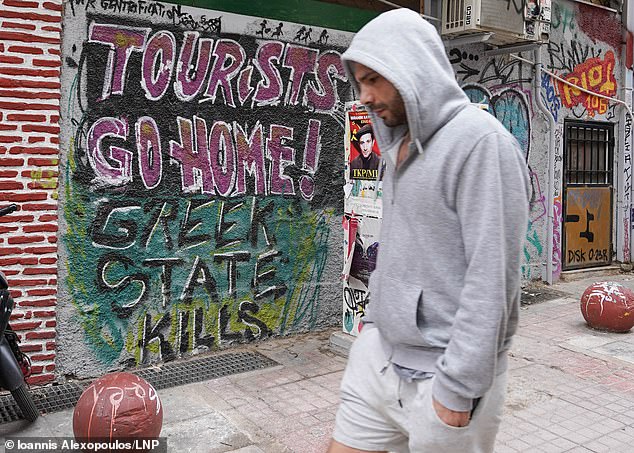Fury in Italy as world famous rock with dinosaur footprints is defaced with ‘tourists go home’ graffiti
A world-famous rock, which has preserved dinosaur footprints, has been defaced with ‘tourists go home’ graffiti.
The anti-tourism slogan was scrawled next to the prehistoric footprints dating back more than 220 million years, sparking outrage in the country.
Paralympian and climber Moreno Pesce made the shocking discovery while training in the Dolomites in northern Italy, as reported by ANSA.
In a video posted online, the athlete is seen shaking his head as he demonstrates his findings.
Mr Pesce said: ‘It was not a pleasant awakening for the Tre Cime’.
Paralympian and climber Moreno Pesce made the shocking discovery while training in the Dolomites in northern Italy

The slogan against tourism was scrawled next to the prehistoric footprints that are more than 220 million years old

The Dolomites are a tourist hotspot in Italy with more than four million visitors every year
The vandalism took place between the Auronzo and Lavaredo mountains, home to some of the most popular hikes in Italy.
The dinosaur footprints were discovered in 1992 and are thought to have been formed during the Triassic period, between 250 and 200 million years ago.
This discovery led to similar findings in the Dolomites and experts believe that this area was the site of a real dinosaur trail in prehistoric times.
During the summer, approximately four million tourists flock to the scenic mountain range every year.
It follows a wave of anti-tourism protests across Europe this summer, mainly popping up in British holiday hotspots across Spain.
Earlier this month, a thousand protesters took to the streets in Ibiza calling for more restrictions on tourism to the island as locals claim Ibiza’s transformation into a ‘luxury destination’ was causing serious socio-economic problems for residents.
The march was organized by major anti-tourism platform Caviem el Rumb, which has been holding demonstrations in the Spanish holiday hotspot all summer.
Meanwhile, on the neighboring island of Mallorca, anti-tourism protests have rocked the Balearic island this summer.

Protests against holidaymakers escalate into sinister twist as ‘kill a tourist’ graffiti appears on wall in Mallorca

Protesters shot water guns at tourists eating at popular spots in Barcelona in July

Earlier this month, a thousand protesters took to the streets in Ibiza calling for more restrictions on tourism to the island as locals claim Ibiza’s transformation into a ‘luxury destination’ was causing serious socio-economic problems for residents.
The island saw a record 17.8 million tourists last year, but now locals are demanding a curb on the number of foreign visitors visiting Mallorca.
In July, around 50,000 residents took to the streets of the Mallorcan capital Palma.
The anti-tourism protests then took a sinister turn when graffiti reading ‘kill a tourist’ was spotted in the town of Manacor.
The center-right Partido Popular party condemned the act of vandalism and urged Manacor town hall to “cooperate in the immediate clean-up.”
PP spokesperson Maria Antonia Sanso said the graffiti did not represent the general feeling of Manacor residents and called the act “totally unjustified.”
Also in July, locals in Barcelona took to the streets demanding a reduction in the millions of tourists who flock to the city every year.
Protesters carried signs reading “Barcelona is not for sale” and “Tourists go home,” before some, armed with water pistols, began spraying restaurateurs in popular tourist hotspots.
As some stopped at hotel entrances, shouts of “Tourists from our area” were heard.
Rising housing costs in Barcelona, which have risen by 68 percent in the past decade, are one of the main issues facing the movement, along with the effects of tourism on local trade and working conditions in the city of 1.6 million inhabitants.
Tenerife saw one of the largest organized anti-tourism activities: on April 20, more than 200,000 demonstrators took to the streets.
Anti-tourist graffiti has appeared elsewhere in Europe, both in Naples and the Greek capital Athens.

Thousands of people demonstrate against tourism policy on the island of Tenerife, Canary Islands, Spain on April 20, 2024

In the photo: a counter where tourists can buy a day ticket for Venice, seen on April 25

Chilling graffiti in Athens reads: ‘Tourists go home! Greek state kills
Governments have also started using legislation in an attempt to curb the number of tourists. From April 25 this year, tourists arriving in Venice will have to pay a daily fee of €5 (£4.30) to enter during peak hours under a pilot scheme.
Authorities hope the fee will discourage visitors from arriving on peak days and make the city more livable for its dwindling population.
Last year, Amsterdam made headlines when officials in Amsterdam urged British tourists to ‘stay away’ from the city.
The initiative was launched as part of an effort to revamp the image of the Dutch capital, which has become known in recent years for its liberal drug policies and famous red-light district.
In the Amsterdam campaign, called ‘Stay Away’, people were shown warnings when they searched online for terms such as ‘bachelor party Amsterdam’ or ‘pub crawl’.
“The campaign starts in Great Britain and focuses on men in the age category of 18 to 35 years,” the municipality of Amsterdam said in a statement at the time.
